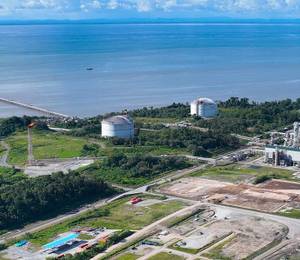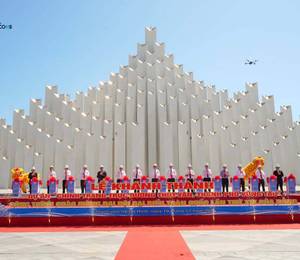Malaysia’s Mass Rapid Transit Corporation (MRT Corp) is believed to be one of the first in Asia that has leveraged cloud-based collaboration on a common data environment, for its 51-km Klang Valley Mass Rapid Transit (KVMRT) system’s Sungai Buloh–Serdang–Putrajaya (SSP) line.
In partnership with Microsoft’s Global ISV, Bentley Systems, MRT Corp aims to complete the project on-time and within budget, benefitting from a projected 35 percent productivity increase in the design, construction and operation of this infrastructure through seamless information sharing and collaboration powered by Microsoft Azure.
The Azure-hosted Bentley Systems platform enabled MRT Corp to increase the precision of construction, reduce instances of design rework and to improve safety standards by enabling seamless synchronisation and information exchange between external vendors. It has enabled all project disciplines to work dynamically using a federated model for coordinated design, despite the participation of numerous external vendors and decentralised information on this complex project.
Multi-layered challenges
MRT Corp said it faced several challenges with the construction of the KVMRT SSP line. One of the key issues in the previous SBK line project was that there were too many site changes during construction, resulting from design discrepancies arising from either design changes or site constraints. In addition, MRTC has to manage 30 percent more consultants involved in the SSP line, all of whom would have to have direct access to the common database in order to continuously update design information, eliminating outdated and misinterpreted information.
“One of the key challenge faced with any mega civil construction project like ours is ensuring seamless information exchange, and real-time collaboration among stakeholders, regardless of the platforms they are using. The probability of error is high if the information is not managed on a common data environment, especially in a highly collaborative project like ours. These types of errors could lead to construction delays and increased costs due to change orders and rework to rectify issues,” explained Poh Seng Tiok, director of planning and design at MRT Corp.
With the increased use of mature Building Information Modelling (BIM) methodology in civil construction projects, a cloud-based, intelligent 3D model-based process provides many advantages for mega-scale infrastructure projects similar to the KVMRT SSP line. However, even as BIM methodology matures from the use of 2D CAD and electronic print-based processes to 3D CAD and electronic data sharing based on industry standards, the added complexity that comes with multiple teams involved in the project meant that MRTC needed to address how best to collaborate seamlessly across teams.
(Below: modelling of the SSP Line. Image: MRT Corp)

Mr Poh said, ”This issue was further aggravated with the manpower and talent crunch, and the local government’s ambitious plan to raise labour productivity levels aggressively by 2020. This meant that MRTC needed to adopt a platform to ensure quick, secure and efficient onboarding of its engineers for the project; while ensuring an improved level of productivity. The platform deployed allowed the team to identify potential issues through visualisation, where the advanced modelling helped its engineers quickly detect any design clashes.”
Bentley Systems and Microsoft Azure
“Therefore, MRTC decided to adopt a BIM maturity level 2 strategy for the KVMRT SSP Line, as well as the use of a common data environment CDE for a collaborative workflow to cut the reliance of manual processes. It is the first metro project in Asia to adopt BIM level 2, an advanced way of working that leverages digital collaboration and has become a standard for many leading governments for public-sector projects,” added Mr Poh.
“With this implementation, all parties involved can use their own 3D BIM models, but design information is shared through a common data environment, which enables any organisation to combine data with their own to create a federated BIM model.”
(Below: A model of the KVMRT line built with Bentley Systems’ solutions, and powered by Microsoft Azure. Image: MRT Corp)

MRTC chose Bentley System’s ProjectWise and AssetWise to manage both the execution of this project and future asset management. By leveraging Microsoft’s Azure cloud services, ProjectWise and AssetWise enable all project disciplines to work dynamically using a federated model for coordinated design. With a cloud-based platform, information can be shared across various parties involved, reducing the risk of data loss and rework due to misinterpretation.
This Connect Edition ProjectWise and AssetWise solutions make the design, construction and operation of infrastructure assets easier for owners, consulting firms, and their supply chains around the world. This model of coordination also enables the integration of design and asset information with operation and maintenance systems to ensure optimal asset performance throughout the project and asset lifecycle.
With this deployment, MRTC was able to conduct a fortnightly Virtual Design Review process, allowing its diverse teams to review and coordinate their respective models, regardless of locations. This process standardised collaboration across all teams and helped identify and mitigate potential issues, before they impacted cost, schedule and safety. This is a large improvement from work on the first KVMRT line (SBK line) that relied on 2D drawings and a traditional Electronic Document Management System (EDMS) workflow.
The approach is expected to increase productivity by an estimated 35 percent, while reducing design rework by providing accurate information the project team could trust. Mr Poh highlighted, “The team is confident to see much less re-work on site, which will help us meet our goal of delivering the project within the targeted time and cost.
“We have seen improvements in the execution of the SSP line, despite the increased complexities faced. For example, we were able to reduce the number of on-site resolution meetings, which required the attendance of all stakeholders, as the Virtual Design Review allowed us to identify design clashes in earlier stages. More importantly, embracing digital has enabled MRTC to improve our productivity, while also enabling our workers to acquire new skillsets necessary to adhere to the BIM standards, which will be mandatory in civil engineering projects from 2020.”
Kaushik Chakraborty, VP, regional executive, Asia South, Bentley Systems, commented, “The KVMRT project is an example of how the world’s infrastructure projects are undergoing digital transformation through the power of cloud services to improve project delivery and asset performance. Together with Microsoft, we are pleased to see organisations tapping the power of the cloud to realise the potential of real-time business insights and collaboration to deliver greater efficiency in a highly complex industry.”
The KVMRT SSP line project has been named winner of BIM Advancements in Rail and Transit category in Bentley’s 2017 Be Inspired Awards programme.
Related article:
Asia construction projects get more advanced with BIM











